How do basidiomycetes grow?
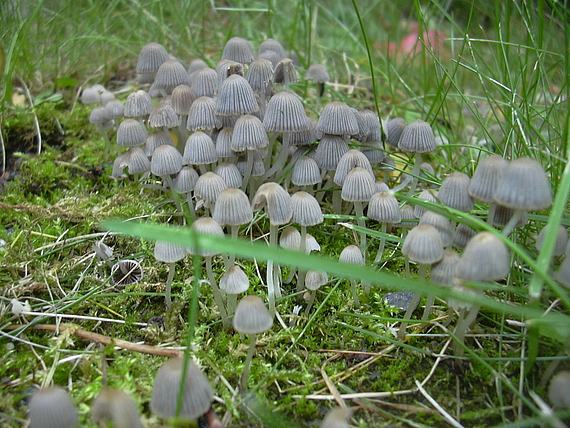
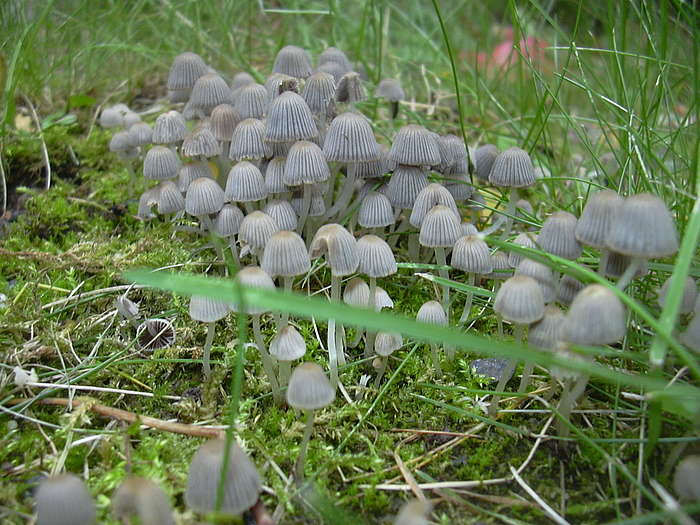
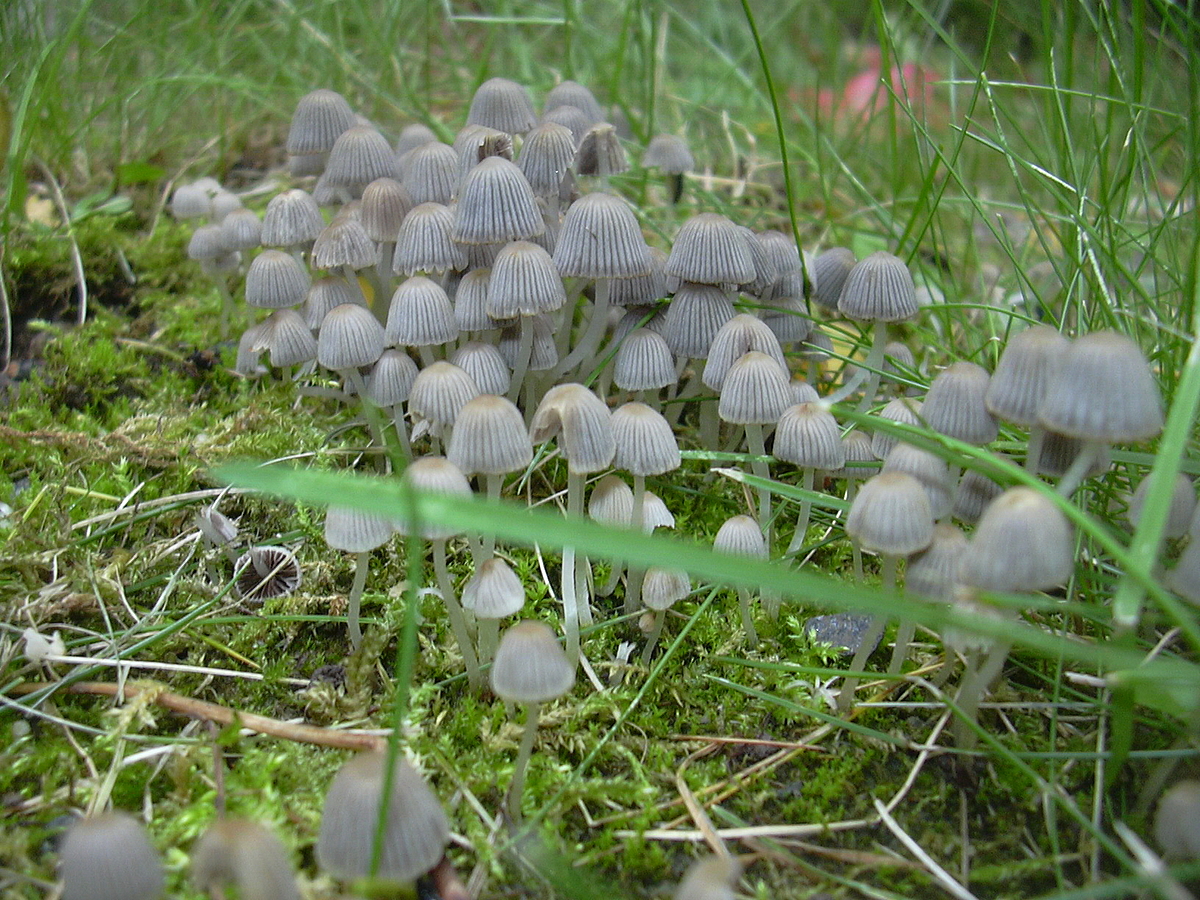
Saprotrophic basidiomycetes are commonly found inhabiting forest detritus, forest soils, leaf litter, and fallen trees. The vegetative cells survive and spread out in the sub-terranean sphere.
Other important groups of basidiomycetes grow symbiotic with trees in form of mycorrhizae, and there are also various pathogenic species. Determined by environmental factors, such as nutrient availability, temperature and moisture, basidiomycetes switch to a sexual stage, where typical fruiting bodies (pile and hat) are developed. The fruiting body contains the basidiospores, single reproductive cells which are dispersed by wind, rain or insects to form new vegetative mycelium on the new location.
White and brown rot fungi
Basidiomycetes (usually species from the subphylum Agaricomycotina) are the only known aerobic microbes capable of degrading wood. This material mainly consists of cellulose and hemicelluloses which are polyglycosides, encrusted by lignin which is a three-dimensional network built of phenylpropanoid units. This composite polymer is the most abundant and the most recalcitrant organic material on earth.
White rot fungi like Phanerochaete chrysosporium preferably attack lignin, leaving behind a bleached material, mainly crystalline cellulose. To achieve this decomposition of lignin, they secrete a unique constellation of degradative enzymes. With the aid of the typical lignin-modifying enzymes, such as lignin peroxidase, manganese peroxidase, versatile peroxidase, and phenol-oxidases of the Laccase type they literally thrive on woody materials. Environmental contaminants, such as polychlorinated biphenyls, pentachlorophenol, and polycyclic aromatic hydrocarbons, are also attacked, if they possess chemical structures similar to lignin. As a result, they are crucial to soil mineralisation and the circulation of carbon from the atmosphere into organisms and back again.
Brown rot fungi like Piptoporus betulinus (birch polypore, of which Ötzi the Iceman carried fruiting bodies with him) preferably attack the polysaccharide portion of wood and do not produce significant activities of lignin-degrading enzymes.
Why should we care about basidiomycetes?
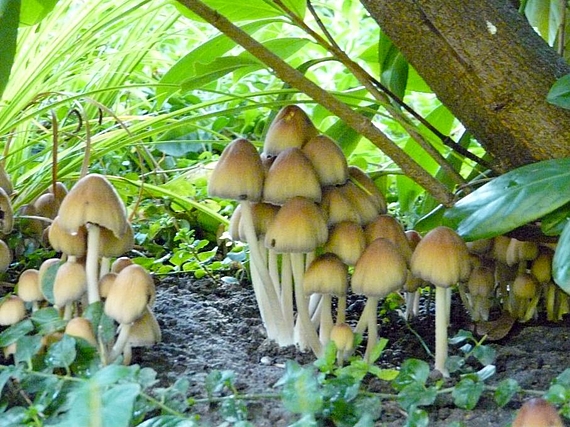
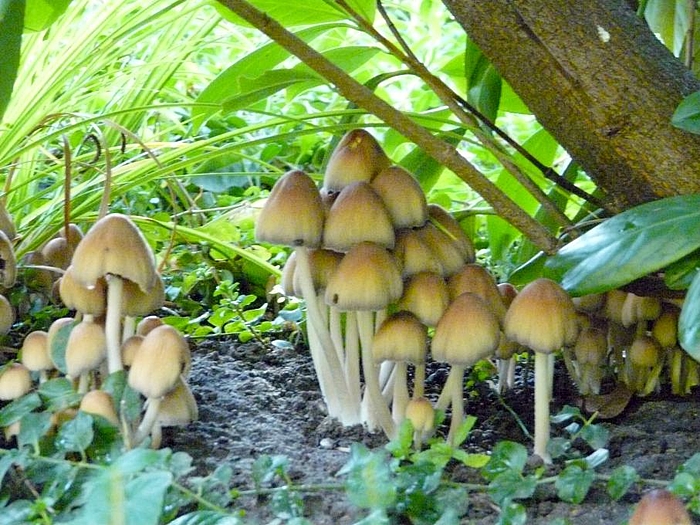
Among the estimated roughly 20,000 mushroom forming species (Ainsworth and Bisby´s Dictionary of the Fungi, ed. 9; 2001) are many economically important agricultural species (mainly from the class Agaricomycetes, subphylum Agaricomycotina). Solely in China, 950 different members are known to be edible and consumed as a food, of which about 50 are commercially cultivated (Rühl and Kües 2007). Worldwide, Agaricus bisporus (champignon, white button mushroom) is the most cultivated species followed by Lentinula edodes and Pleurotus spp. . Plant pathogens, such as rusts (members of the Pucciniomycotina) and smuts (members of the Ustilaginomycotina), and some opportunistic human pathogens (from the order Filobasidiales within the subphylum Agaricomycotina) are Basidiomycetes as well.
Due to their specific enzyme dispositions acting at decomposition of plant material and by the multiple kinds of unusual secondary metabolites they produce, particularly Agaricomycotina have found unique interest in biotechnology. Various species are edible and well established as part of human diets whilst benefits for medicine are attributed to others.
Chary in the choice of their plant counterpart, the preferred tree species of symbiotic, pathogenic or wood-rotting fungi is often reflected by the taxonomic name (birch-betulinus, oak-quercophilus, pine-pini; wood-silvaticus, silvicola).
Some of them grow easily in and on agricultural wastes, such as manure and straw. Others require wood chips or sawdust. On the agro-industrial scale, induction of fruiting is not easy to control; commercial cultivation still poses challenges to mushroom producers.
Previously, in vitro cultivation was thought to be complicated and non-reproducible, but meanwhile fast-growing species were identified. Laboratory cultivation of basidiomycetes is typically carried out emerged on organic substrates and in solid state bioreactors; submerged cultivation in shake flasks and stirred-tank reactors has become laboratory standard for the rapid production of larger amounts of homogeneous biomass.
Enzymes from basidiomycetes - Unique tools for biotechnology
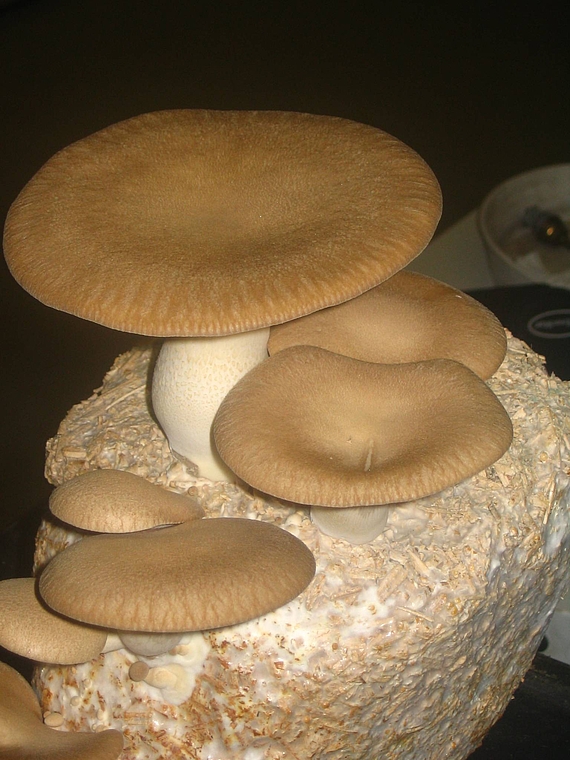


A network of polycondensates and phenylpropanoid polymers, called lignin, forms the xylem cell wall of lignified higher plants. Recalcitrant to physical and chemical degradation, it provides protection to any environmental attack. However, many fungi of the phyla Basidiomycota and Ascomycota thrive of wood forming an impressive morphological diversity of fruiting bodies for the dissemination of their spores. Among the xylotrophic basidiomycetes, representatives of the white-rot fungi, such as Pleurotus, Phanerochaete, Phlebia and Trametes species have received special attention. White-rot decay is mainly based on extracellular hydrolases and oxidoreductases, coded by divergent gene families. These unique enzymes are not only a functional component of complex communities in soil and forest and part of the global carbon cycle, but they are also attractive candidates for future industrial biotechnologies. Particular advantages of extracellular enzymes are
- operational stability,
- good water solubility, and
- a multitude of reactions catalyzed.
Potential applications in fine chemistry, biofuel production, food, agricultural, paper, textile and cosmetic industry, and also in bioremediation have been patented and reviewed.The major types of enzymes are laccase (a phenol oxidase) and heme peroxidases. Support comes from H2O2-generating enzymes, such as glucose or glycerol oxidases, from hydrolases, such as glycosidases and esterases, and from redox mediators and mechanisms generating free radicals.Laccase, lignin peroxidase, and manganese peroxidase appear to be secreted according to substrate requirements in the respective ecological niche. Lignin peroxidase was shown to oxidize directly at the protein surface via a long-range electron transfer process. Side chain and aromatic ring cleavage products of both phenolic and non-phenolic substrates have been characterized spectrometrically. Laccase and manganese peroxidase, which oxidize phenols, but non-phenolic moieties only in the presence of mediators, degrade lignin stepwise. Single enzymes have not yet been shown to delignify intact lignocellulose. Likely reasons may be that the peroxidases act synergistically and require smaller helper molecules to penetrate lignified tissues.
The geometry and catalytic action of the copper centres of laccases have been elucidated in detail. Various sub-types, such as the yellow laccases were described. Enzymes with pronounced stability against surfactants, metal ions or physical extremes were detected in extended screenings. Recently, a strategy of combining directed evolution with rational approaches generated a heterologous thermostable, high-redox potential laccase.
Another unique and well-characterized fungal oxidoreductase is versatile peroxidase. The substrates oxidized range from Mn2+, the manganese peroxidase substrate to veratryl alcohol, the typical lignin peroxidase substrate; and phenols, the substrates of Coprinopsis cinerea peroxidase. The hybrid properties result from the coexistence of different catalytic sites in a single enzyme. A versatile peroxidase of Mycetinis scorodonius was the first fungal redox enzyme produced in an Aspergillus host in high activity yields. The enzyme degraded carotenoids in the presence of hydrogen peroxide and was capable of bleaching whey containing Anatto. Several billion liters of colored whey originating from the production of Gouda and Cheddar cheese have to be handled every year, and around one third of the added colorant remains in the whey. Chemical bleaching, disposal into sewage plants, and enzymatic degradation are the alternatives. A recombinant peroxidase was produced in gram per liter yields for this purpose and is now marketed as MaxibrightTM. The hydrogen peroxide required may be elegantly provided in situ by a glucose oxidase, which is supplied with substrate by a ß-galactosidase. Nature acted as a model for this three-enzyme solution.
The processing of paper, textiles, dyes, alcoholic mashes and leather also results in highly colored effluents. A special sub-type of peroxidases, the so-called dye decolorizing (DyP) peroxidases may turn out useful in the treatment of such effluents. Only a handful of these enzymes have been characterized more thoroughly. The successful treatment of heavily contaminated industrial soil with living basidiomycetes indicates that the selective degradation of ecotoxic xenobiotics is within reach.
Another fungal speciality is peroxygenase. The extracellular enzyme of the agaric basidiomycete, Agrocybe aegerita oxidized toluene and 4-nitrotoluene via the corresponding alcohols and aldehydes to benzoic acids. Both oxygen atoms incorporated were derived from the co-substrate H2O2. The peroxygenase resembled cytochromes P 450 and heme chloroperoxidase in catalyzing benzylic hydroxylations.
Valencene dioxygenase of the edible basidiomycete Pleurotus sapidus converted the sesquiterpene (+)-valencene to the grapefruit flavor (+)-nootkatone through intermediate hydroperoxides. Expression of the enzyme in E. coli was improved by various strategies including cold shock expression, chaperone co-expression, and employment of mutant E. coli strains. Up to 60 mg of catalytically active enzyme was produced. Quantitative substrate screenings showed the enzyme to be a true lipoxygenase. Such a pronounced substrate promiscuity is not uncommon with basidiomycete enzymes. 2-Oxoglutarate- and Fe2+-dependent dioxygenases are supposed to be involved in nucleic acid modifications, more specifically in oxidative modification of the 5-Me group of cytosine to 5-hydroxymethylcytosine. The Tet/JBP homologs from basidiomycetes showed a tight linkage with genes encoding predicted transposases. If so, these dioxygenases, and perhaps also valencene dioxygenase, were another element of epigenetic regulation.
Less well researched oxidoreductases are cellobiose dehydrogenase and pyranose 2-oxidase. Both are presumed to participate in lignin breakdown, but act on the polysaccharide part of lignin. Here, the first step is hydrolysis and depends on the activity of cellulases, hemicellulases, esterases phosphatases and other hydrolases. The hydrolase activities are often, but not necessarily correlated with the oxidoreductase activities. Some laccases and peroxidases are less stable in the environment than extracellular hydrolases, but stability, pI, pH optima and other properties determined in vitro can generally not extrapolated to more complex chemical surroundings or the situation in a real ecosystem.
The hydrolysis of cellulose or hemicelluloses, such as mannans, pectins, xylans and the like is typically achieved by the joint action of endo- and exo-specific enzymes, de-branching and de-esterifying enzymes together with enzymes acting on oligomer and dimer forms. Cloning and heterologous expression of fungal hydrolases, such as β-glucosidases, α-galactosidases, β-mannosidases, and acetyl esterases was successful in various expression systems with production at levels up to grams per L and with high purity paving the way for industrial production and application. Cellulose is the most abundant polysaccharide on Earth, and a potential source of glucose. Basidiomycetes belong to its most potent degraders using a set of hydrolytic enzymes composed of endoglucanase, cellobiohydrolase and β-glucosidase. Mechanisms producing hydroxyl radicals based on cellobiose dehydrogenase may complement the toolbox.
Peptidases from basidiomycetes are as diverse as other classes of enzymes. They are often distinguished by uncommon substrate specificity and stability under extreme conditions of pH, temperature and ion strength. Their functions range from simple nitrogen supply to the regulation of physiological processes by limiting the life time of other enzymes. High peptidase activity was found, among others, in Flammulina velutipes, Armillaria mellea, Trametes versicolor, Meripilus giganteus and Hericium erinaceus. Surface cultures of Flammulina velutipes, an edible mushroom enjoying high popularity in Asian cuisines, grew well on many industrial side-streams and yielded over 160.000 aU mL-1 of peptidase activity when cultivated on wheat gluten pellets. Gelatin zymography visualized a complex mixture of peptidases secreted. Among them was an enzyme which catalyzed the deamidation of l-asparagine and l-glutamine. The enzyme was purified to electrophoretic homogeneity by foaming and SEC and showed remarkable tolerance towards elevated temperature and sodium chloride concentration in both the native and recombinant form, and no significant homology to any conserved domains of published asparaginases or glutaminases.
A peptidase of Piptoporus soloniensis showed a milk clotting activity similar to chymosin from milk calves. The aspartic peptidase contained an amino acid partial sequence that was more homologous to mammalian milk-clotting peptidases than to the chymosin substitute from a fungal species, such as Mucor miehei. According to SDS-PAGE patterns, the peptidase cleaved κ-casein in a way similar to chymosin and hydrolyzed β-casein slowly, as would be expected from an efficient chymosin substitute.
Lipases and ester bond cleaving activities in general were frequently found in basidiomycetes. An extra-cellular lipase from Pleurotus sapidus was the first enzyme of the lipase/esterase family from a basidiomycetous fungus characterized on the molecular level and expressed in a manageable host. Expression of the cDNA in Escherichia coli led to the production inclusion bodies with low catalytic activity. Refolding yielded a catalytically active protein which hydrolyzed bulky xanthophyll esters with high efficiency. A signal sequence which directed the accumulation of the protein to the periplasmatic space increased the yield of soluble enzyme. Esters of benzylic and phenylpropanoid acyl moieties with polysaccharides occur widely in plant materials and are the substrate of various activities currently termed feruloyl esterases. While previous attempts to classify these enzymes were based on substrate specificity, more recent approaches involved pharmacophore models. The increasing knowledge on the genomes of xylotrophic fungi is expected to develop sequence based and less ambiguous classification systems. For the time being, the accumulating genetic data facilitate gene fishing and the assignment of new sequences to a certain enzyme class.
Industrial Perspectives: Bioactives and Enzymes
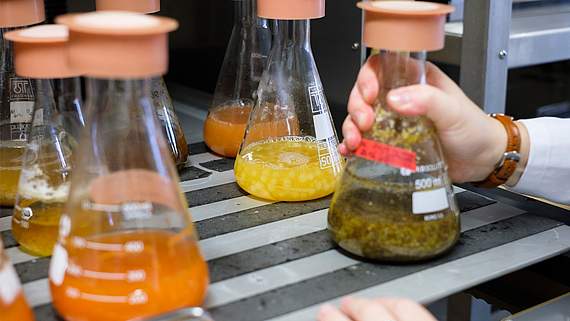
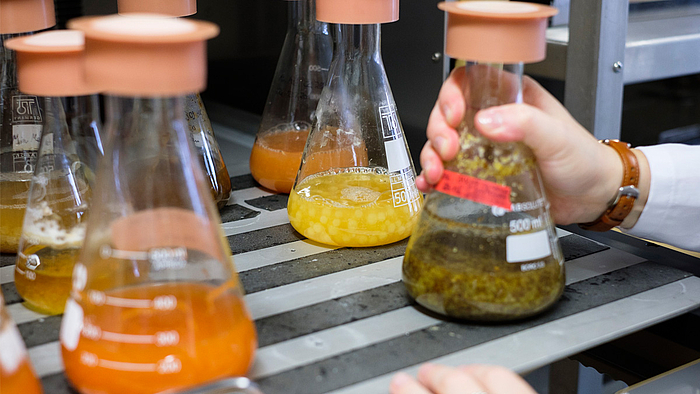
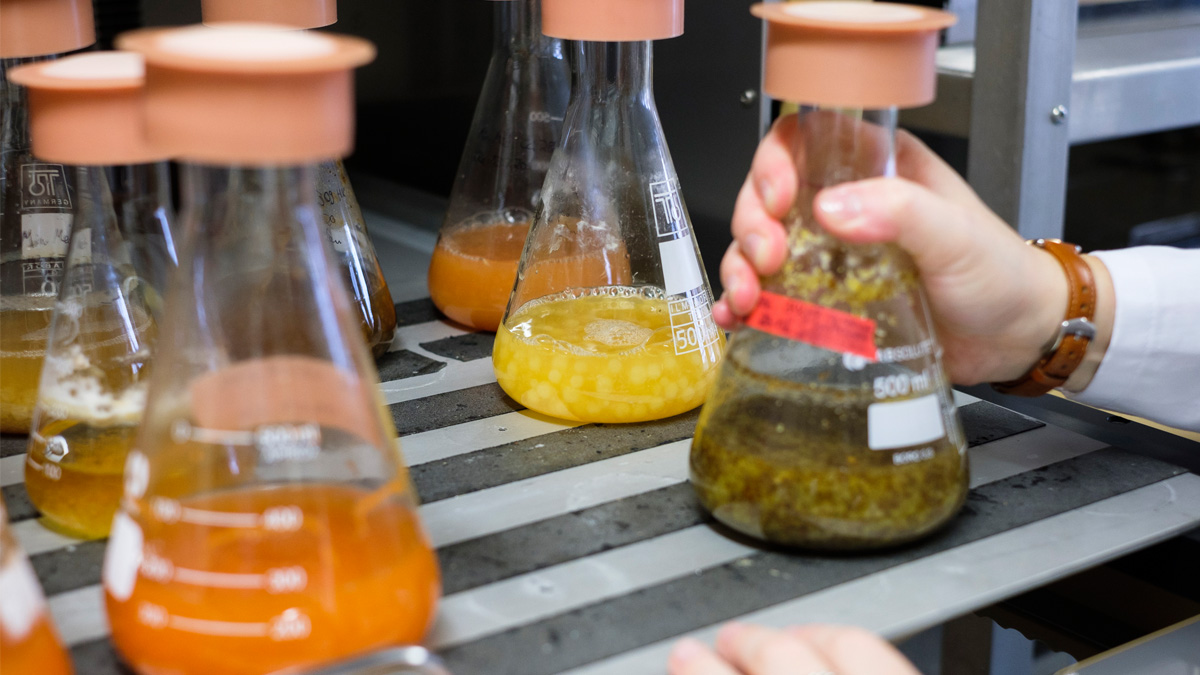
Among the many complex low-molecular secondary metabolites produced by Basidiomycetes are many of industrial interest, such as flavors, colorants or pharmaceuticals. The yield of these metabolites may be increased by the choice of growth substrate or by direct supplementation with metabolic precursors (biotransformation and bioconversion).
Compounds possessing anticancer, antibacterial, antiviral, antifungal, antidiabetic, anti-inflammatory, cardioprotective and other activities were reported. Low-molecular metabolites as well as some polycondensates were identified as responsible principles responsible. In various edible mushrooms inhibition of lipid oxidation and cyclooxygenase activity was mediated by linoleic acid, ergosterol, ergosterol peroxide and a glycosphingolipid. A polysaccharide, called Pleuran, possessing activity against Ehrlich ascites carcinoma and an esophageal cancer cell line was identified as a highly branched ß-D-glucan with 1-3 and 1-6 linkages in Pleurotus ostreatus. Schizophyllan, a homoglucan with a β-1,3-linked backbone and β-1,6-linked single glucose units, is produced by Schizophyllum commune and now explored as a yield enhancer in oil drilling.
In many cases, medicinal properties and chemical structures were difficult to correlate. Protection against breast cancer has been assigned to a reduced in situ production of estrogen through an unknown aromatase inhibitor. The pharmaceutical potential appears yet far from being fully explored.
The enzymes of white rot fungi possess or promise to receive industrial application in fields, such as of wood and textile processing and in converting renewable materials into fuels and fine chemicals. Fungal pre-treatment of wood chips, for example, is expected to be crucial in the utilization of agricultural wastes for the large-scale production of bioethanol. Because of their unique constellation of enzymes, basidiomycetes can degrade problematic dyes and environmental toxins. Therefore, these enzymes are suitable in environmental biotechnology for the de-colorization and decontamination of polluted water and other contaminated material.
With the advent of molecular biology, more and more species are also accessible by genetic engineering through DNA transformation techniques. Genetic engineering allows influencing production yields and will make possible in the future the production of better enzymes as well as of more and new metabolites.


